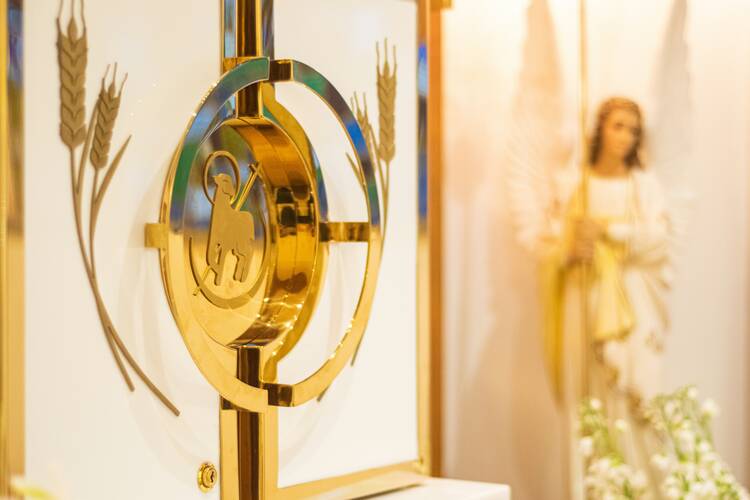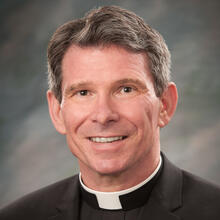A Homily for the Solemnity of the Most Holy Body and Blood of Christ
Readings: Genesis 14:18-20 1 Corinthians 11:23-26 Luke 9:11b-17
Have you ever been in a debate and found yourself defending a position that seemed a bit off-kilter, even to you? Somewhere in the points and counterpoints, you went too far, not that you would admit it in the heat of the argument.
Many Catholics believe that Protestants deny what we call “the real presence” of Christ in the Eucharist. Some do, but others hold views very close to our own.
There are as many Protestant understandings of Christ’s presence in the Eucharist as there are denominations. And an unintended consequence of the 16th-century Reformation was the transfer of doctrinal primacy from confessional communion to individual opinion in many Christian cultures. And—let’s be honest—even within Roman Catholicism, individual opinion does not always correspond to magisterial teaching.
Let’s examine an unfortunate development in contemporary debates regarding Christ’s presence in the Eucharist. It has surfaced in the recent Eucharistic revival. At gargantuan expositions of the Blessed Sacrament, some commentators now say things such as “Jesus has entered the arena” or “Jesus is now making his way down Fifth Avenue.” To speak this way is not so much incorrect as it is insufficient.
There is a reason that we have traditionally spoken of Christ’s presence in the Eucharist as the “Blessed Sacrament.” We speak of exposing and reposing the sacrament, but we have not spoken of bringing Jesus out of, or locking Jesus back into, the tabernacle.
This is always a useful way to discern whether a new linguistic usage corresponds to the fullness of Catholic truth. Can it be used in all the traditional ways?
Those who now refer to “Jesus” in procession do so with the right intention. They want to affirm, as they often say, that Christ is present “body, blood soul and divinity” in the Eucharist. Good enough, but in failing to distinguish the eucharistic presence of Christ from the one who walked among us 2,000 years ago, they also fail to acknowledge the miracle that Christ wrought for us.
Christ ascended body and soul to heaven. In Eucharist, though we acknowledge that the whole Christ is truly present—body, blood, soul and divinity—we do not cannibalistically consume his physical body, which remains glorified in heaven. Yet we truly feed upon the Lord himself. As the Council of Trent put it in its response to the Protestant Reformation,
For there is no repugnance in this, that our Savior sits always at the right hand of the Father in heaven according to the natural mode of existing, and yet is in many other places sacramentally present to us in His own substance by a manner of existence which, though we can scarcely express in words, yet with our understanding illumined by faith, we can conceive and ought most firmly to believe is possible to God (“Decree Concerning the Most Holy Sacrament of the Eucharist,” 1. Italics added).
In the Eucharist, we encounter Jesus in the manner that he himself determined that we would: sacramentally.
The word “sacramentum” was the Latin equivalent of St. Paul’s Greek word, “musterion,” which meant mystery. Paul had insisted that what God does in human history is beyond our capacity to understand completely. So it makes perfect sense to speak of Christ’s presence in the Eucharist as being a mysterious presence, a sacramental presence.
As is so often the case in the pursuit of orthodoxy, we must balance two apparently contradictory affirmations: Christ himself is truly present in the Eucharist, yet something has changed from the way in which he was previously present to us during his ministry. It is the risen and glorified Christ who comes to us in the Eucharist.
The evangelists prepare us for this mystery. In their resurrection accounts, they insist that the risen Christ is the very one who has died. Yet when he returns to us, he is at first unrecognizable because something is radically different. Jesus is transformed in glory! Only his true intimates recognize who is in their midst, and they need his assistance, the gift of faith, to do so.
These Gospel accounts underscore an essential revelation: This new Christ, this risen Christ, is not bound by our understandings of space and time. And in the sacraments, Christ claims dominion over both.
Pope St. Leo the Great may have put it best when he said that “what our redeemer made manifest in his own person has passed over into the sacraments (quod itaque Redemptoris nostri conspicuum fuit in sacramentatransivit, Sermon 74, 2).”
The problem with saying that “Jesus is in the building” is the failure to acknowledge the miracle of Christ’s passing over into the sacraments, all the while remaining entirely his own self.
In our intimate, devotional prayers, we can, of course, address this presence as “Jesus,” “my savior” and “my beloved Lord.” For this is the one who once walked among us. But our public language must recognize both what remains and what has been transformed. Christ has passed over into the sacraments. We speak of taking the “Blessed Sacrament” to those who are sick, but we do not shove “Jesus” into the glovebox as we drive there.
One way to enter the mystery of Christ’s sacramental presence is to compare what Christ wrought in our history with what happens in the inner Trinitarian life of God. The Father begets the Son. All that the Father is passes over, yet into, the Son. Each is fully God, yet the Father does not become the Son nor, the Son, the Father.
Something analogous happens in the resurrection: The incarnate Christ brings forth, rises as, the glorified Christ. His new presence among us is infused with, empowered by, the Holy Spirit. Both are the same Lord, yet one is radically different from the other. To deny this is to deny the wondrous miracle of the resurrection.
Now the same song but in a new key! In his resurrection, the incarnate Christ has become the sacramental Christ. Both are the same Lord, yet one is radically different from the other. To disavow either the contrast or the continuity is to deny the wondrous miracle of the Eucharist! Like the Father, Christ virginally begets his own radically real and utterly new presence among us: He brings forth the church and her sacraments.
From beginning to end, all of this bears the mark of the Holy Spirit: the virginal conception, Christ rising from the dead, Christ giving himself to us as sacrament. The Spirit bridges difference while maintaining distinction: between Father and Son, between the earthly and the resurrected Christ, between who God is in himself and what God gives to us in sacrament.
Enthusiasm leads us to say a lot of things, often without necessary measure. In our lives of faith, we sometimes do the same. Thank God that the Spirit, who came forth from the tomb along with Christ, infuses the church, the full body of believers, that Christ left to us. We help each other maintain the full, apostolic truth of who Christ is for us.








